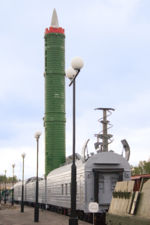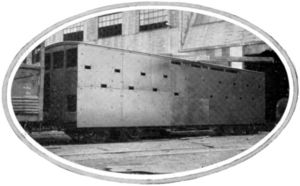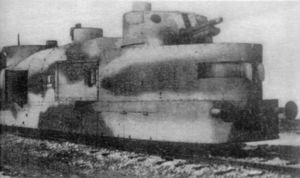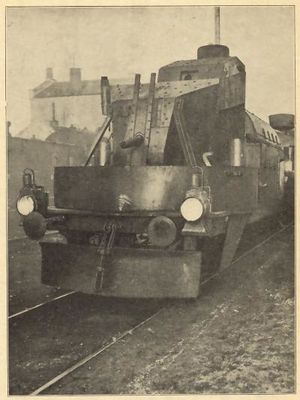Armoured train
An armoured train is a train protected with armour. Usually they are equipped with artillery and machine gun railroad cars. Their use was the most common during late 19th and early 20th century.
Design and equipment
The railroad car on an armoured train are designed for many roles. The typical roles include:
- Artillery - fielding mixture of guns and machine guns
- Infantry - designed to carry infantry units, may also mount machine guns.
- Machine gun - dedicated to machine guns
- Anti-air - equipped with anti-air guns
- Command - similar to infantry wagons, but designed to be a train command center
- Anti-tank - equipped with anti-tank guns, usually in a tank turret
- Platform - unarmoured, with purposes ranging from transport of ammunition or vehicles, through track repair or derailing protection to railroad ploughs for railroad destruction.
- Missile transport - both Russia and the US had railway-based ICBMs by the late 1980s; no such systems remain in operation today.
Different types of armour were used to protect from attack by tanks. In addition to various metal plates, cement and sandbags were used in some cases.
Armoured trains were sometimes escorted by a kind of rail-tank called a draisine.
History
Armoured trains saw use during the 19th century in the American Civil War (1861-1865), the Franco-Prussian War (1870-1871), the Boer Wars (1880-81 and 1899-1902), and the First (1914-1918) and Second World Wars (1939-1945). The most intensive use of armoured trains was during the Russian Civil War (1918-1920). There are also reports of a limited use of armoured trains in the Second Chechen War (1999-).
During the Boer War on 15 November 1899, Winston Churchill, then a war-correspondent, was travelling onboard an armoured train when it was ambushed by Boer commandos. Churchill and many of the train's garrison were captured, though many others escaped, including wounded placed on the train's engine.
After the First World War the usage of armored trains declined. They were used in China in the twenties, most notably by the warlord Zhang Zongchang, who employed refugee White Russians to man them.
Poland used armoured trains extensively and successfully during the Invasion of Poland, which in turn prompted Nazi Germany to reintroduce them into its own armies.
Germany used armored trains to a small degree during World War Two, however, they introduced significant designs of versatile and well equipped nature, including railcars which housed anti-aircraft turrets, railcars designed to load and unload tanks, and railcars which had complete armor protection with a large concealed howitzer gun. Germany also had impressive locomotives which were used on such trains and were fully armored.
Fulgencio Batista’s army operated an armored train during the cuban revolution though it was derailed and destroyed during the battle of Santa Clara

Towards the end of the Cold War, both superpowers began to develop railway-based ICBMs mounted on armoured trains; the Soviets deployed the SS-24 missile in 1987, and the US started to follow suit with the Peacekeeper missile, but budget costs and the changing international situation led to the cancellation of both programs, with all remaining railway-based missiles on both sides finally being deactivated in 2005.
One armored train that remains in regular use is the private train of Kim Il-sung and Kim Jong-il, which the former received as a gift from the Soviet Union.
An armoured train named "Krajina ekspres" (Krajina express) was used during the war in Croatia (part of the Yugoslav succession wars) of the early 90's by the army of Republika Srpska Krajina (self-proclaimed republic of Serbs living within Croatia that sought to remain in Yugoslavia). The train was used successfully as a mobile artillery battery (some AA guns were also mounted) due to lack of danger from the air (Croatia then possessed only a few aircraft - mostly converted ex-crop dusters used as bombers). It was reportedly hit on few occasions with some antitank self-propelled grenades, but the damage was minor, as most of the train was covered with thick sheets of rubber which caused the grenades to explode somewhat too early to do real damage. The train was finally destroyed by its own crew lest it fall into enemy hands during the Croatian offensive "Storm" which overran the Srpska Krajina.
Tactics
The advantage of armoured trains is that they can be quickly moved across great distances (which was especially important in the extremely mobile Russian Civil War). They can also carry a large quantity of supplies (including ammunition and materials for track repairs).
The obvious disadvantage is that they are tied to rail tracks, and destroying tracks immobilizes them. They are also easy to spot and destroy from the air. Because of this, armoured trains have virtually disappeared since World War II.

See also
External links
| Wikimedia Commons has media related to: Armoured trains |
Quotes
- "Poland had only few armoured trains, but their officers and soldiers were fighting well. Again and again they were emerging from a cover in thick forests, disturbing German lines"
- from the history of Wehrmacht: "Wie das Gesetz es befehl"
de:Panzerzug ja:装甲列車 pl:Pociąg pancerny pt:Comboio blindado ru:Бронепоезд sk:Pancierový vlak sl:Oklepni vlak




